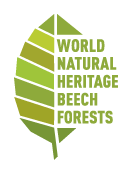Forests for Europe
Scientific literature is consistent on the fact that primary and old growth forests in Europe, although occupying a very limited area, are irreplaceable in harbouring biological diversity, stabilising terrestrial carbon storage, regulating hydrological regimes, enabling ecosystem adaptation to disturbances, and public health benefits. The importance of forest habitats for the European biodiversity and its function to remove carbon from the atmosphere, convert CO2 into biomass and create significant carbon sinks is underlined by the European Biodiversity Strategy 2030. The strategy clearly states the crucial demand to define, map, monitor and strictly protect all the EU’s remaining primary and old growth forests. Up to now, the protection of primary and old growth forest is limited by several shortcomings, which need to be overcome.

Challenges to solve

Nowadays, a European wide standard to assess the status of naturalness of a forest doesn’t exist. There is no set of broadly acknowledged indicators and thresholds between the forest sector and nature conservation across the EU.
We lack a homogenous mapping guideline or map sets of primary or old growth forests available across EU. There are some national or regional maps from already known old growth forests, but spatial scopes and methods of classification are varies. The lack of widely accepted classification schema and the limited scope hinders the delineation and protection of the last fragments of these important forest ecosystems.
Beside these limitations of getting a European wide overview on these important forests, the awareness on the importance of ecosystem services provided by the old growth forest ecosystem must be strengthened and communicated to policy makers and broad public at the same time. Forestry and timber processing industry still follow the argumentation that the harvesting of wood needs to be increased to substitute fossil energy, carbon-emission intensive (construction) materials or to store carbon in the wood product pool. But the potential to increase carbon sequestration by natural forest ecosystems and promote the long-term storage of carbon in living and dead biomass and soils is underestimated in the discussions and decision making processes. several other additional ecosystem services, like the potential of recreation, providing habitats for plants, animals and fungi or their cooling-effect on local and regional climate are provided. These services are provided to a broad public but do not have a marked price and are not evaluated adequately against the economic impact of timber logging and processing.
Network
The project builds on the UNESCO World Heritage site of ancient and primeval beech forest, with a view to benefit from the solid network that has already been created and from the strong engagement of landowners, local communities, and authorities to conserve these areas and integrate them in local sustainable development strategies. In general, the Natural World Heritage sites in EU-Countries overlap with Natura 2000 sites

Official context
The project will contribute to the implementation of the EU Biodiversity Strategy to 2030, to the achievement of the objectives and ambition of the European Green Deal on forest protection and to the better implementation of the Habitats and Birds Directives. All activities will take into account the existing European policy and legal framework applicable to primary and old growth forests.

Recognition
The positive attitude towards the Natural World Heritage and the strictly protected forest ecosystems shall be used to strengthen the protection and recognition of old growth forests in Europe
